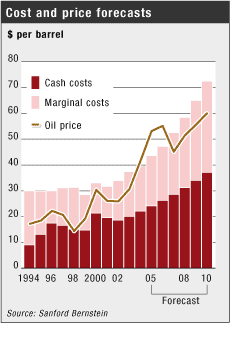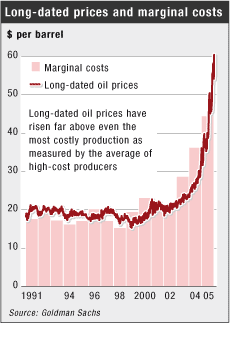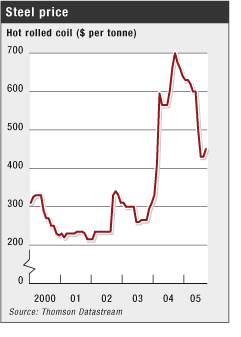By Carola Hoyos and Thomas Catan
Published: August 30 2005 20:13 | Last updated: August 30 2005 20:13![]()
 As
the 200mph gusts lashing the Louisiana coast subsided on Tuesday, oil
companies operating in the Gulf of Mexico were left counting the cost of
the latest big hurricane to torment the region.
As
the 200mph gusts lashing the Louisiana coast subsided on Tuesday, oil
companies operating in the Gulf of Mexico were left counting the cost of
the latest big hurricane to torment the region.
The four that struck there last year resulted in around $28bn of damage across all sectors, according to Aon, the US insurance company. Premiums climbed for anyone operating in the area – and, following the damage wrought this week by Hurricane Katrina, industry experts expect those to rise further. “It will certainly harden the resolve of underwriters to look for premium increases for the Gulf of Mexico business,” says Tim Fillingham, heads of energy at Aon’s UK arm.
It is just one more element in a story of escalating costs faced by oil companies operating around the world. The lack of qualified staff to operate rigs, especially in the US and in the North Sea, a scarcity of oil rigs for hire and the higher cost of raw materials such as steel are adding to upward pressure on crude prices as well as impinging on the sector’s ability to find and produce new oil. Bargaining by oil-rich countries is strengthening the squeeze: countries such as Venezuela are demanding hundreds of millions of dollars more in taxes and royalties for existing and future projects. The rapidly increasing costs of doing business for oil companies is starting to be felt by consumers at the petrol pump.

Neil McMahon, analyst at Sanford Bernstein, sees cost inflation as a key factor behind the escalation in crude oil prices. “The oil and gas industry is a marginal business like any other,” he writes in a research note. “If costs rise, commodity prices must escalate to sustain returns for the marginal player.”
The issue of costs might not get much attention as hurricanes, terrorist threats to oil production, the dwindling spare capacity of oil in Saudi Arabia and the insatiable thirst for energy in China and the US. But cost inflation is being viewed as a significant reason why oil prices are so high and a sign that they will remain so for some years to come. Sanford Bernstein expects the cost of producing a single barrel of oil to increase by 9 per cent a year, from about $22 a barrel this year to $36 in 2010, and the cost of finding and producing the so-called marginal barrel – beyond which the activity becomes unprofitable – will double to $60 over the same period. Uncertainty about how much new projects will cost also prompted Goldman Sachs this month to raise its prediction of the long-term oil price from $45 a barrel to $60.
This week’s hurricane shut down 1.4m barrels a day of production – equivalent to about 7 per cent of US demand. Chevron, the country’s second largest energy group, had the greatest number of rigs in the storm’s path. But hundreds of operators are set to face losses that they will eventually pass on to consumers. There is little that companies can do in the face of ferocious weather. But what are the other business costs that are prone to escalate and what are upstream oil and gas companies doing to limit the damage?
For a start, with oil prices at record highs, companies are scrambling to extract as much from their existing fields as possible and are pushing to find new resources. Spare drilling rigs are difficult to come by and dramatically more expensive.
In 1990 companies paid some $93 to drill one foot ($284 a metre). In 2003, the most recent year for which data is available, the cost in real terms had more than doubled to $204 per foot, according to the International Energy Agency, the developed countries’ energy watchdog. Hiring a deep-water rig for a day in the Gulf of Mexico costs $400,000, double the price of five years ago. Smaller rigs that drill in shallower water have more than tripled in price.
This was before Hurricane Katrina ripped through the heart of the US oil industry, passing over nearly half of the 231 rigs looking for oil in the Gulf of Mexico. A total of 117 rigs – worth $7bn – lay in its path, of which 48 were hit by winds of more than 74mph, according to Rigzone, the industry news outlet. A full damage assessment has yet to be made, but preliminary indications are not good. With often only a single spare rig available for hire in the region, Katrina is likely to be a huge setback.
Even before the hurricane, oil service companies were battling to meet demand. During the lean years of the 1990s, when oil prices were low, companies invested little and are scrambling to catch up. “Oilfield activity is very strong around the world,” says Stephen Whittaker, director of communications at Schlumberger, the oil services group. “We’ve seen an increasing demand for oilfield service technologies over the past two years in response to growing global energy needs.”

Revenues have benefited but oil service companies worry that they could start to be affected by the increase in the price of raw materials and the shortage of available staff. Gene Shiels, assistant director for investor relations at the rival Baker Hughes, says: “So far the oil services industry has been able to increase prices ahead of the raw materials increase and pass the cost – and then some – along to their consumers, such as national and international oil companies.” But some raw materials, especially strong steel that does not easily corrode, are becoming difficult to find because of fierce competition from China.
Steel prices rose 70 per cent last year to $650 per tonne but have since retreated to about $500. The impact has been more immediate for those oil companies that have been hit by steelmakers renegotiating contracts as the price rise for steel has outstripped the penalty for breaking an agreement.
Because of the pressures, national and international oil companies have had sharply to increase their estimates of how much projects will cost. At today’s oil prices, that should not matter too much, but oil companies worry that multi-billion-dollar projects could be rendered unprofitable if oil prices were to drop back. Until the costs become clear, some will opt to hold back at a time when the world is desperate for new supplies of oil and gas.
”Costs have increased significantly over time and it’s now hurting some of our projects,” says Ali al-Hammadi, chief operating officer for Qatargas, the Gulf state’s liquefied natural gas producer. “There aren’t enough engineering, procurement and construction contractors, there aren’t enough shipyards and the prices are going up.”
Saudi Arabia, the largest supplier of crude and holder of the most reserves, is also seeing costs rise but from a lower level. Ali Naimi, the kingdom’s oil minister, is not yet concerned. He says: “Commodities worldwide are up. Steel, cement, all the parts, machinery, it’s all going up. But when you are talking of a less than $2 producing cost . . . there is no pressure.”
But as countries such as Saudi Arabia are not letting oil multinationals tap their resources, groups such as Royal Dutch Shell, BP, Total, ExxonMobil and Chevron have been pushed into exploring and extracting in ever more remote and hostile territory. It is here that they are being hit hardest.
Getting people to work on a large project is difficult if the skills that are required are specialised or the location remote, as Royal Dutch Shell recently found. The cost of its gas project at Sakhalin Island, off the east coast of Russia, has ballooned to $20bn – twice the original estimate. The group says the rising price of services and raw materials are in large part to blame.
Shell’s other mammoth projects, in Nigeria and Canada, have also been hit by rising costs. It recently warned that the cost of expanding its oilsands project at Athabasca, in the Canadian province of Alberta, was set to climb. “It is clear that there is a significant upward trend in construction costs due to the heated global market for engineered equipment and bulk materials,” Shell Canada said. There are also indications that the company’s Pearl Gas-to-liquids project in Qatar is rising in cost. In the light of the cost overruns, Shell is reviewing its capital expenditure budgets, which could rise from the expected $15bn a year.

BP has been relatively successful at holding down costs but still expects its capital cost estimates to rise from $14.5bn this year to some $15bn next year. At the last results presentation, Lord Browne, chief executive, said he expected costs to keep rising. “The market for the typical mix of goods and services that we procure in the exploration and production sector went up about 9 per cent in 2004,” he said. “We saw that trend continue in 2005 and we expect it to continue in 2006. Of course, we do not just sit still and take this; we use technology and the fact that we are a very big buyer of goods and services to get the leanest possible prices.”
Rising costs have also hit ExxonMobil, though it says it has been
able to mitigate them through good project management. “We’re all
dealing with the same industry environment and market forces and really
the key in differentiating performance is how you manage those costs,”
said Lee Raymond, ExxonMobil’s chief executive, when presenting its
results. “The things that have differentiated our performance in the
past are even more important in this kind of environment,” he added,
citing project management, advance planning and technology as ways of
holding costs down.
Companies with well-organised procurement systems that locked in rig rates early, such as ExxonMobil, will be less affected by the price rise than those who did not act in the same way, says the chief executive of one large European oil company. He adds that the real crunch for him and his competitors will come in a few years, when international and national oil companies ready to invest in large projects – such as the one being planned in Russia’s Arctic region – are forced to compete to get the services they need. “There are only three companies that can do that kind of work and they will be able to name their price.”
Oil services companies are not alone in driving a hard bargain. Countries rich in oil are demanding a bigger slice of the growing oil revenue pie from their international partners, thereby pushing up the cost of finding and producing oil. Most, such as Nigeria and Kazakhstan, are setting tough terms for new contracts. But some, including Venezuela and Russia, are rewriting existing rules to win higher payments.
What has changed in the past few weeks is that those costs are beginning to affect oil prices on the futures markets in New York and London and at the pumps across the world. If oil companies cannot curb their costs, will consumers alter their behaviour? The American Petroleum Institute, the energy companies’ umbrella group, yesterday called on Americans to consume energy wisely in the light of the hurricane – echoing a sentiment that Opec, the IEA and many oil companies have expressed several times this year.
If consumers heed that call, prices may ease gradually. Otherwise it may not need another Katrina for havoc to be wreaked in the market.
Companies find few takers for jobs that have lost their attraction
An unusual visitor knocked recently at the door of the John 3:16 Mission – a shelter for the homeless – in the tough inner city of Tulsa, Oklahoma, writes Carola Hoyos. The visitor had a mission of his own: to recruit workers for the rigs that dot the US state, which is rich in oil and natural gas.
As the oil and gas industry tries to meet surging demand, companies are struggling as never before to find the staff they need – from labourers to engineers and other professionals. It is one more reason why costs are rising in the industry.
In the US and Europe in particular, oil companies are facing “the Big Crew Change” – a phrase coined by the Society of Petroleum Engineers, which represents industry professionals worldwide. The average age of the industry’s employees is 49 and half the workforce will retire in the next five to 10 years, according to most analysts and oil industry groups. The trouble is in part a result of the lean 1990s when low oil prices prompted large numbers of redundancies and a slowdown in recruitment.
The unwillingness of many Americans and Europeans to do hard manual labour and the tightness of the US labour market have made it difficult to find workers for jobs such as cleaning rigs, which pay as much as $17 an hour – more than three times the federal minimum wage.
Royal Dutch Shell, the Anglo-Dutch energy group, and other companies in Louisiana are finding recruits for their on- and offshore rigs among young high school drop-outs. In June, the first seven students graduated from a programme of the American Petroleum Institute, the industry association, and Jobs Corp, an education and vocational training programme administered by the US Department of Labor, which trains students in safety and well operations and helps them to complete their high school equivalency exam.
Meanwhile, the vilification of oil companies by environmental and human rights groups has made an industry career less appealing for those with more skills, oil company executives say. BP alone has hired 13 search agencies to fill 400 vacancies at its Houston-based operations.
Even places such as Angola – which emerged only this decade from 27 years of civil war – are being trawled by some companies operating there for talent to fill top jobs.
In one company, Shell, the recruitment problems go all the way to the top: analysts think that Europe’s second biggest energy group – which had a reputation as a training ground for the industry’s brightest – lacks qualified candidates eventually to fill top rank posts such as chief executive and head of exploration and production. Concern over filling such posts is seen as a drag on the company’s share price.
How well each company deals with the Big Crew Change may not only determine its pecking order among its peers, but also how well the industry as a whole is able to meet the challenge of supplying a thirsty world with oil.